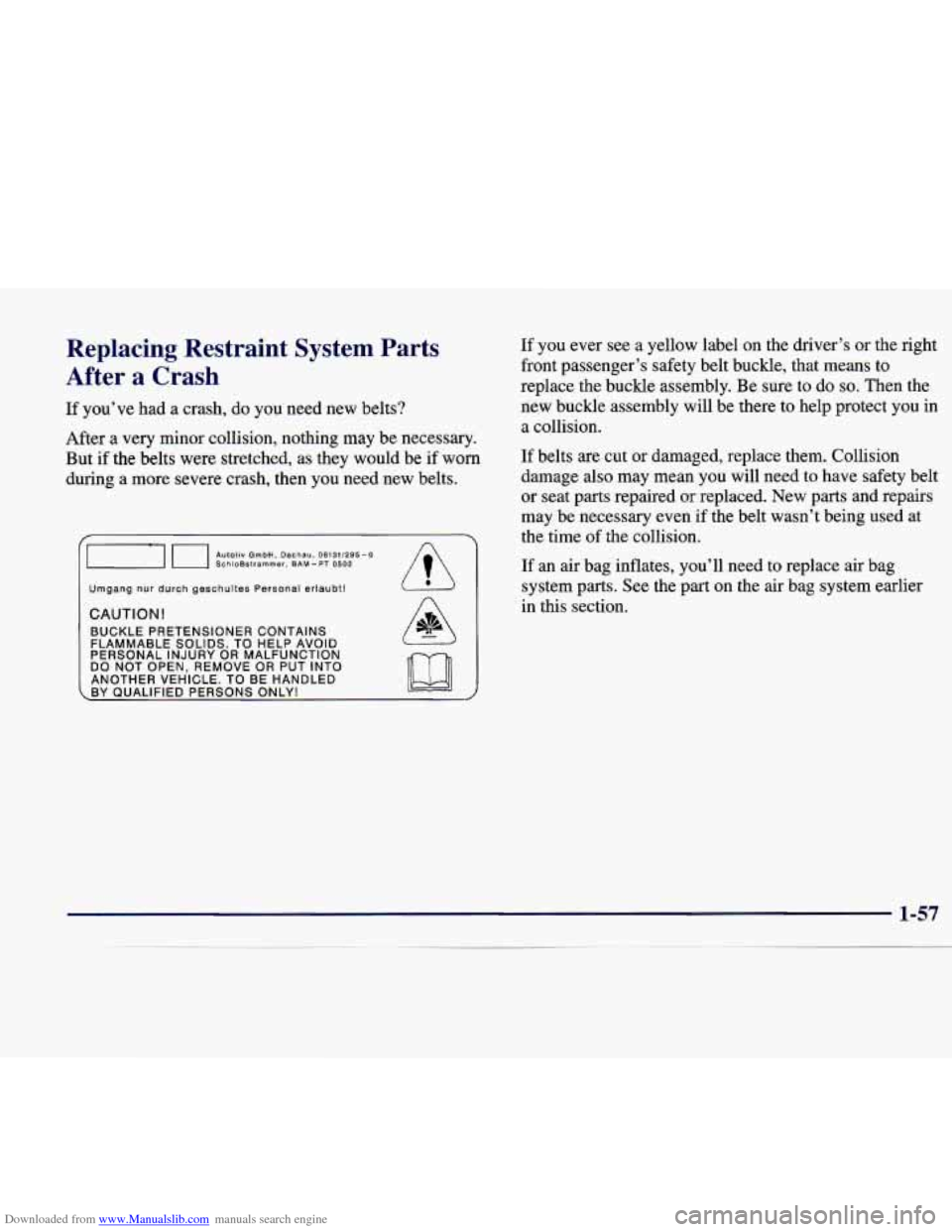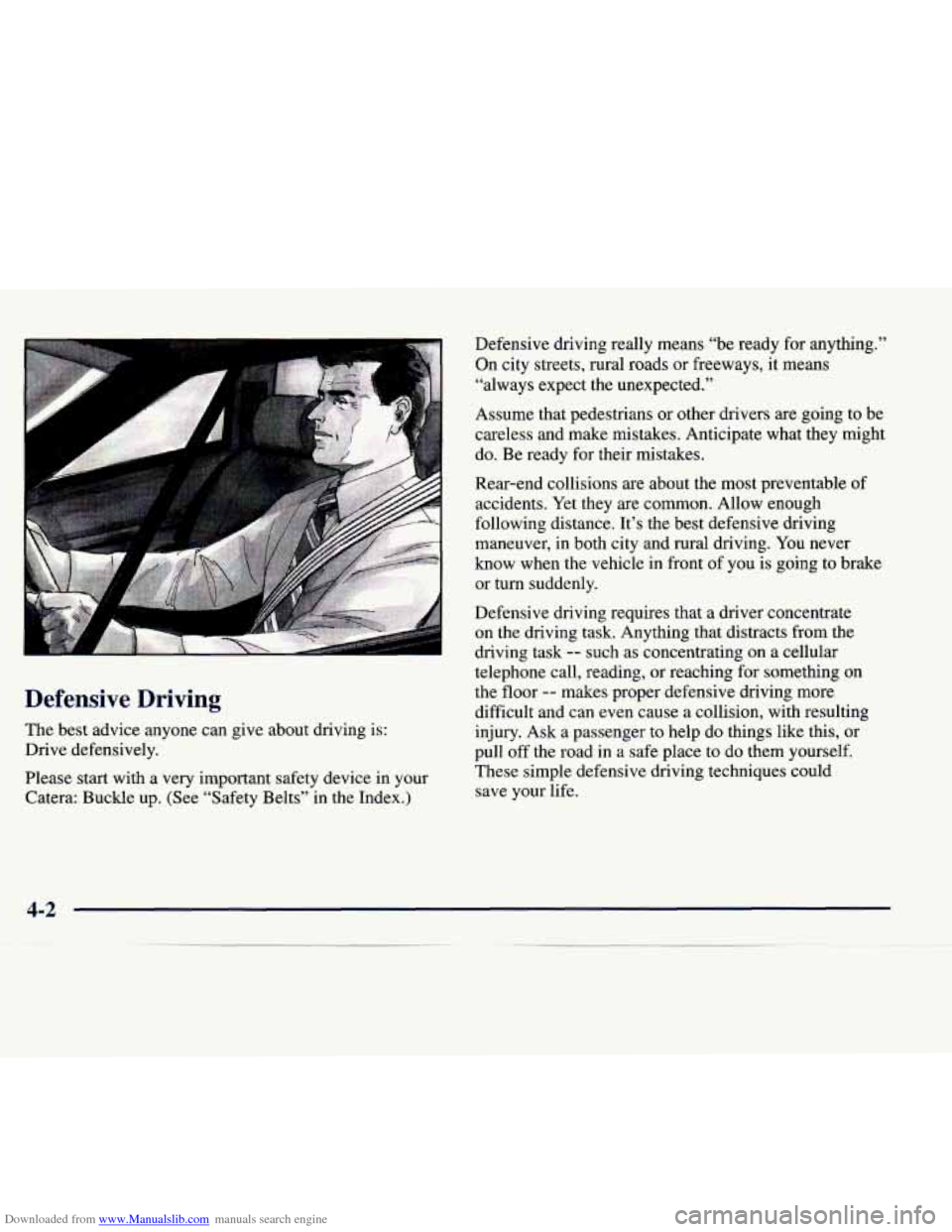1998 CADILLAC CATERA belt
[x] Cancel search: beltPage 69 of 346

Downloaded from www.Manualslib.com manuals search engine Safety Belt Extender
If the vehicle’s safety belt will fasten around you, you
should use it.
But if a safety belt isn’t long enough to fasten, your
dealer will order you an extender. It’s free. When you go
in to order it, take the heaviest coat you will wear,
so the
extender will be long enough for you. The extender will
be just for you, and just for the seat in your vehicle that
you choose. Don’t let someone else use it, and use it
only for the seat
it is made to fit. To wear it, just attach it
to the regular safety belt.
Checking Your Restraint Systems
Now and then, make sure the safety belt reminder light
and all your belts, buckles, latch plates, retractors and
anchorages are working properly. Look for any other
loose or damaged safety belt system parts. If you see
anything that might keep a safety belt system from
doing its job, have
it repaired.
Torn or frayed safety belts may not protect you in a
crash. They can rip apart under impact forces. If a belt
is torn or frayed, get a new one right away.
Also look for any opened
or broken air bag covers, and
have them repaired or replaced. (The air bag system
does not need regular maintenance.)
Page 70 of 346

Downloaded from www.Manualslib.com manuals search engine Replacing Restraint System Parts
After a Crash
If you’ve had a crash, do you need new belts?
After a very minor collision, nothing may be necessary.
But if the belts were stretched, as they would be if worn
during a more severe crash, then you need new belts.
SchloBstrammer, BAM -PT 0502 Autoliv GmbH, Dachau, 08131/295-0
Umgang nur durch geschultes Personal erlaubtl
CAUTION!
BUCKLE PRETENSIONER CONTAINS (4& FLAMMABLE SOLIDS. TO HELP AVOID
PERSONAL INJURY OR MALFUNCTION DO NOT OPEN, REMOVE OR PUT INTO ANOTHER VEHICLE. TO BE HANDLED
BY QUALIFIED PERSONS ONLY!
If you ever see a yellow label on the driver’s or the right
front passenger’s safety belt buckle, that means to
replace the buckle assembly. Be sure to do
so. Then the
new buckle assembly will be there to help protect you in
a collision.
If belts are cut or damaged, replace them. Collision
damage also may mean you will need
to have safety belt
or seat parts repaired
or replaced. New parts and repairs
may be necessary even if the belt wasn’t being used at
the time of the collision.
If an air bag inflates, you’ll need to replace air bag
system parts. See the part on the air bag system earlier
in this section.
1-57
Page 75 of 346

Downloaded from www.Manualslib.com manuals search engine Door Locks
A CAUTION:
-- - -
Unlocked doors can be dangerous.
Passengers
-0 especially children 0- can easily
open the doors and fall out. When
a door is
locked, the inside handle won’t open it.
Outsiders can easily enter through an unlocked
door when you slow down or stop your vehicle.
This may not be
so obvious: You increase the
chance
of being thrown out of the vehicle in a
crash if the doors aren’t locked. Wear safety belts
properly, lock your doors, and you will be far
better
off whenever you drive your vehicle. There
are several ways to lock and unlock your vehicle.
From the outside,
use your key or the remote keyless
entry transmitter. This will avoid setting
off the optional
theft-deterrent
alarrn.
From inside your vehicle,
slide the lock lever down to
lock the door.
To unlock the
door, slide the lock lever up.
Page 135 of 346

Downloaded from www.Manualslib.com manuals search engine Warning lights come on when there may be or is a
problem with one of your vehicle’s functions. As you
will see in the details on the next few pages,
some
warning lights come on briefly when you start the
engine just to let you know they’re working. If you are
familiar with this section, you should not be alarmed
when this happens.
Gages can indicate when there may be
or is a problem
with one of your vehicle’s functions. Often gages and
warning lights work together to
let you know when
there’s
a problem with your vehicle.
When one of the warning lights comes on and stays on
when you are driving, or when one of the gages shows
there may be a problem, check the section that tells
you
what to do about it. Please follow this manual’s advice.
Waiting to do repairs can be costly
-- and even
dangerous.
So please get to know your warning lights
and gages. They’re a big help.
Safety Belt Reminder Light
When the key is turned to ON or START, a chime will
come on for about eight seconds to remind people to
fasten their safety belts, unless the driver’s safety belt i\
s
already buckled.
The safety belt light will
also come on and
stay on
for about four seconds,
then it
will flash for about
60 seconds. If the driver’s
belt is already buckled,
neither the chime nor the light will come on.
Page 176 of 346

Downloaded from www.Manualslib.com manuals search engine When using a scrubbing action, non-abrasive cleaning
cassette, it
is normal for the cassette to eject because
your unit is equipped with a cut tape detection feature
and a cleaning cassette may appear as
a broken tape. To
prevent the cleaning cassette from being ejected, use the
following steps.
1. Turn the ignition to ON (11).
2. Turn the radio off.
3. Press and hold the SOURCE button for two seconds.
The tape symbol on the display will flash three times.
4. Turn the radio on and insert the scrubbing action
cleaning cassette.
5. Eject the cleaning cassette after the manufacturer's
recommended cleaning time.
When the cleaning cassette has been ejected, the
cut tape
detection feature is active again.
You may also choose a non-scrubbing action, wet-type
cleaner which uses a cassette with a fabric belt to clean
the tape head. This type of cleaning cassette will not
eject on its own. A non-scrubbing action cleaner may
not clean as thoroughly as the scrubbing type cleaner.
The use of a non-scrubbing action, dry-type cleaning
cassette is not recommended. If your vehicle is
equipped with the
AM-FM Stereo with
Cassette Tape Player, press and hold the eject button for
five seconds to reset the CLN indicator after you clean
the player. The radio will display
--- to show the
indicator was reset.
If your vehicle is equipped with the AM-FM Stereo with
Cassette Tape and Compact Disc Player with Radio Data
Systems
(RDS), press and hold the eject button for three
seconds to reset the CLEAN TAPE indicator after you
clean the player. The radio will display CLEAN TAPE
MSG CLEARED to show the indicator was reset.
Cassettes are subject to wear and the sound quality
may degrade over time. Always make sure the cassette
tape is in good condition before you have your tape
player serviced.
Page 181 of 346

Downloaded from www.Manualslib.com manuals search engine Defensive Driving
The best advice anyone can give about driving is:
Drive defensively.
Please start with a very important safety device in your
Catera: Buckle up. (See "Safety Belts" in the Index.) Defensive driving really means
"be ready for anything."
On city streets, rural roads or freeways, it means
"always expect the unexpected."
Assume that pedestrians or other drivers
are going to be
careless and make mistakes. Anticipate what they rnight
do. Be ready for their mistakes.
Rear-end collisions are about the most preventable
of
accidents. Yet they are common. Allow enough
following distance. It's the best defensive driving
maneuver, in both city and rural driving. You never
know when the vehicle in front
of you is going to brake
or turn suddenly.
Defensive driving requires that a driver concentrate on the driving task. Anything that distracts from the
driving task
-- such as concentrating on a cellular
telephone call, reading, or reaching for something on
the floor
-- makes proper defensive driving more
difficult and can even cause a collision, with resulting
injury. Ask a passenger to help do things like this, or
pull off the road in
a safe place to do them yourself.
These simple defensive driving techniques could save your life.
Page 190 of 346

Downloaded from www.Manualslib.com manuals search engine If you need to reduce your speed as you approach a
curve, do it before you enter the curve, while your front
wheels are straight ahead.
Try to adjust your speed
so you can “drive” through the
curve. Maintain a reasonable, steady speed. Wait to
accelerate until you are out of the curve, and then
accelerate gently into the straightaway.
Steering in Emergencies
There are times when steering can be more effective
than braking. For example, you come over a hill and
find a truck stopped in your lane, or a car suddenly
pulls out from nowhere, or a child darts out from
between parked cars and stops right in front of you.
You can avoid these problems by braking
-- if you
can stop in time. But sometimes you can’t; there isn’t
room. That’s the time for evasive action
-- steering
around the problem.
Your vehicle can perform very well in emergencies like
these. First apply your brakes. (See “Braking
in
Emergencies” earlier in this section.) It is better to
remove as much speed as you can from a possible
collision. Then steer around the problem, to the left or
right depending on the space available. An
emergency like this requires close attention and a
quick decision. If you are holding the steering wheel at
the recommended
9 and 3 o’clock positions, you can
turn it a full
180 degrees very quickly without removing
either hand. But you have to act fast, steer quickly, and
just as quickly straighten the wheel once you have
avoided the object.
The fact that such emergency situations
are always
possible is a good reason to practice defensive driving at
all times and wear safety belts properly.
4-11
Page 215 of 346

Downloaded from www.Manualslib.com manuals search engine 2. Let up on the brake pedal.
3. Drive slowly until the trailer is clear of the chocks.
4. Stop and have someone pick up and store the chocks.
Maintenance When Trailer Towing
Parking on Hills
You really should not park your vehicle, with a trailer
attached,
on a hill. If something goes wrong, your rig
could start to move. People can be injured, and both
your vehicle and the trailer can be damaged.
But if you ever have to park your rig on a hill, here’s
how to do it:
1. Apply the regular brakes, but do not shift into PARK (P).
2. Have someone place chocks under the trailer wheels.
3. When the wheel chocks are in place, release the
regular brakes until the chocks absorb the load.
4. Reapply the regular brakes. Then shift into
PARK (P) firmly and apply the parking brake.
5. Release the regular brakes.
When You Are Ready to Leave After
Parking on a Hill
1. Apply your regular brakes and hold the pedal down
while you:
0 Start your engine;
Shift into a gear; and
0 Be sure the parking brake has released. Your
vehicle will need service more often when you’re
pulling a trailer. See the Maintenance Schedule booklet
for more on this. Things that are especially important in
trailer operation
are automatic transmission fluid (don’t
overfill), engine
oil, axle lubricant, drive belt, cooling
system and brake adjustment. If you’re trailering, it’s a
good idea to review this information before you start
your trip.
Check periodically to see
that all hitch nuts and bolts
are tight.
Engine Cooling When Trailer Towing
Your cooling system may temporarily overheat during
severe operating conditions. See “Engine Overheating”
in the Index.
4-36